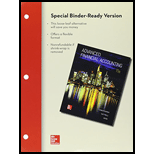
LOOSE-LEAF Advanced Financial Accounting with Connect
11th Edition
ISBN: 9781259605192
Author: Theodore E. Christensen
Publisher: McGraw-Hill Education
expand_more
expand_more
format_list_bulleted
Textbook Question
Chapter 2, Problem 2.9Q
How does carrying securities at fair value differfrom the equity method in reporting income fromnonsubsidiary investments?
Expert Solution & Answer
Want to see the full answer?
Check out a sample textbook solution
Students have asked these similar questions
Explain the concept of materiality in accounting. Need
What is the difference between a contra asset account and a liability? No ai
What is the difference between a contra asset account and a liability?
Chapter 2 Solutions
LOOSE-LEAF Advanced Financial Accounting with Connect
Ch. 2 - What types of investments in common stock normally...Ch. 2 - Prob. 2.2AQCh. 2 - When is equity method reporting considered...Ch. 2 - Prob. 2.4QCh. 2 - Prob. 2.5QCh. 2 - Prob. 2.6QCh. 2 - Prob. 2.7QCh. 2 - Prob. 2.8QCh. 2 - How does carrying securities at fair value...Ch. 2 - How does the fully adjusted equity method differ...
Ch. 2 - Prob. 2.11QCh. 2 - What is the modified equity method? When might a...Ch. 2 - Prob. 2.13AQCh. 2 - Prob. 2.14QCh. 2 - Prob. 2.15QCh. 2 - Prob. 2.16QCh. 2 - Prob. 2.17QCh. 2 - How are a subsidiary’s dividend declarations...Ch. 2 - Prob. 2.19QCh. 2 - Give a definition of consolidated retained...Ch. 2 - Prob. 2.21QCh. 2 - Prob. 2.22QCh. 2 - Choice of Accounting Method Slanted Building...Ch. 2 - Prob. 2.2CCh. 2 - Prob. 2.3ACCh. 2 - Prob. 2.4CCh. 2 - Prob. 2.5CCh. 2 - Prob. 2.6CCh. 2 - Prob. 2.1.1ECh. 2 - Multiple-Choice Questions on Accounting for Equity...Ch. 2 - Prob. 2.1.3ECh. 2 - Prob. 2.1.4ECh. 2 - Prob. 2.1.5ECh. 2 - Prob. 2.1.6ECh. 2 - Multiple-Choice Questions on Intercorporate...Ch. 2 - Prob. 2.2.2ECh. 2 - Prob. 2.3.1ECh. 2 - Prob. 2.3.2ECh. 2 - Prob. 2.3.3ECh. 2 - Prob. 2.3.4ECh. 2 - Cost versus Equity Reporting Winston Corporation...Ch. 2 - Prob. 2.5ECh. 2 - Prob. 2.6ECh. 2 - Prob. 2.7ECh. 2 - Income Reporting Grandview Company purchased 40...Ch. 2 - Prob. 2.9ECh. 2 - Carrying an Investment at Fair Value versus Equity...Ch. 2 - Investee with Preferred Stock Outstanding Reden...Ch. 2 - Prob. 2.12AECh. 2 - Prob. 2.13AECh. 2 - Prob. 2.14ECh. 2 - Prob. 2.15ECh. 2 - Prob. 2.16ECh. 2 - Prob. 2.17ECh. 2 - Changes ¡n the Number of Shares Held Idle...Ch. 2 - Prob. 2.19PCh. 2 - Carried at Fair Value Journal Entries Marlow...Ch. 2 - Prob. 2.21APCh. 2 - Equity-Method Income Statement Wealthy...Ch. 2 - Consolidated Worksheet at End of the First Year of...Ch. 2 - Consolidated Worksheet at End of the Second Year...Ch. 2 - Prob. 2.25PCh. 2 - Prob. 2.26PCh. 2 - Prob. 2.27BPCh. 2 - Prob. 2.28BP
Knowledge Booster
Learn more about
Need a deep-dive on the concept behind this application? Look no further. Learn more about this topic, accounting and related others by exploring similar questions and additional content below.Similar questions
- Joe transferred land worth $200,000, with a tax basis of $40,000, to JH Corporation, an existing entity, for 100 shares of its stock. JH Corporation has two other shareholders, Ethan and Young, each of whom holds 100 shares. With respect to the transfer:a. Joe has no recognized gain. b. JH Corporation has a basis of $160,000 in the land.c. Joe has a basis of $200,000 in his 100 shares in JH Corporation. d. Joe has a basis of $40,000 in his 100 shares in JH Corporation. e. None of the above.arrow_forwardI need help with this general accounting problem using proper accounting guidelines.arrow_forwardI am looking for the correct answer to this general accounting problem using valid accounting standards.arrow_forward
- accounting question?arrow_forwardThree individuals form JEY Corporation with the following contributions: Joe, cash of $50,000 for 50 shares; Ethan, land worth $20,000 (basis of $11,000) for 20 shares; and Young, cattle worth $9,000 (basis of $6,000) for 9 shares and services worth $21,000 for 21 shares. a. These transfers are fully taxable and not subject to § 351. b. Young’s basis in her stock is $27,000. c. Young’s basis in her stock is $6,000. d. Ethan’s basis in his stock is $20,000. e. None of the above.arrow_forwardNonearrow_forward
arrow_back_ios
SEE MORE QUESTIONS
arrow_forward_ios
Recommended textbooks for you
 Cornerstones of Financial AccountingAccountingISBN:9781337690881Author:Jay Rich, Jeff JonesPublisher:Cengage Learning
Cornerstones of Financial AccountingAccountingISBN:9781337690881Author:Jay Rich, Jeff JonesPublisher:Cengage Learning EBK CONTEMPORARY FINANCIAL MANAGEMENTFinanceISBN:9781337514835Author:MOYERPublisher:CENGAGE LEARNING - CONSIGNMENT
EBK CONTEMPORARY FINANCIAL MANAGEMENTFinanceISBN:9781337514835Author:MOYERPublisher:CENGAGE LEARNING - CONSIGNMENT Intermediate Accounting: Reporting And AnalysisAccountingISBN:9781337788281Author:James M. Wahlen, Jefferson P. Jones, Donald PagachPublisher:Cengage Learning
Intermediate Accounting: Reporting And AnalysisAccountingISBN:9781337788281Author:James M. Wahlen, Jefferson P. Jones, Donald PagachPublisher:Cengage Learning


Cornerstones of Financial Accounting
Accounting
ISBN:9781337690881
Author:Jay Rich, Jeff Jones
Publisher:Cengage Learning

EBK CONTEMPORARY FINANCIAL MANAGEMENT
Finance
ISBN:9781337514835
Author:MOYER
Publisher:CENGAGE LEARNING - CONSIGNMENT


Intermediate Accounting: Reporting And Analysis
Accounting
ISBN:9781337788281
Author:James M. Wahlen, Jefferson P. Jones, Donald Pagach
Publisher:Cengage Learning
Financial instruments products; Author: fi-compass;https://www.youtube.com/watch?v=gvxozM3TUIg;License: Standard Youtube License